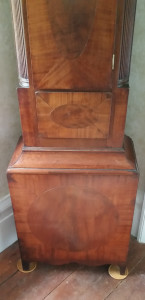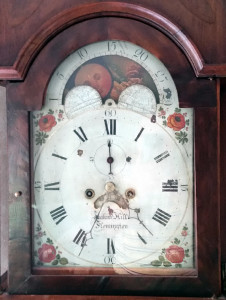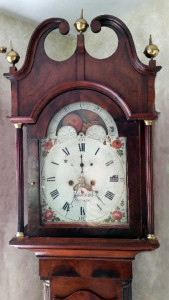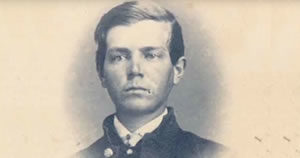 Joachim Hill, a New Jersey clockmaker, was born on November 25, 1783 in Amwell, New Jersey. He reportedly worked and trained with Thomas Williams, another local clockmaker from Flemington, New Jersey. Hill died in 1869 and was buried in the Flemington Presbyterian Church cemetery.
Joachim Hill, a New Jersey clockmaker, was born on November 25, 1783 in Amwell, New Jersey. He reportedly worked and trained with Thomas Williams, another local clockmaker from Flemington, New Jersey. Hill died in 1869 and was buried in the Flemington Presbyterian Church cemetery.
The clock pictured left, at 170 years old, is an outstanding example of the clocks Hill sold. Only modest alternations or additions have been made over the course of its life. This particular piece was presented as a wedding gift to a bride and groom, a common customary gift among farming gentry during the 1820s-1840s. It is a highly-inlaid Mahogany clock of the kind attributed to both Hill and clock case maker James Toping of Chester, New Jersey (some of Hill’s clock cases were reportedly constructed by Toping).
The case itself was artfully refinished sometime in the past sixty years. The inner case construction is typical, showing many beveled-edge glue blocks. There is a hole cut in the top of the case’s (likely original, cloth-covered) blackboard. This is unusual. The stylized French feet are uncut (or unbroken), another notable feature. Many times, the feet on this type of clock were cut or broken off. The case measures 94.5” high and 19” wide.
The dial is a typical painted iron plate with a moon dial. It is stylized J. Hill, Flemington NJ. The flowered corner spandrels add a pleasing visual attribute to the dial corners, while the moon dial artfully shows the typical land and sea scenes found on those similar. The two hemispheres pictures on the left and right of the moon dial aperture base are typical as well. The dial paint is in remarkably good, chip-free condition for its age. The secondhand is a modern addition, and not original to the clock. The crank-winding key appears to be original.
The top bonnet door, a trapezoid cutout, features modern glass. Glazer’s tacks, as opposed to putty, hold the dial cover glass in place. The doorknob of the bonnet is also a modern addition.
The movement has tapered (barrel) movement posts, smooth winding barrel surfaces, and modern braided Dacron cables with old cast iron weights. The cable pullys are made of brass. The pendulum is lightweight, lead-filled bob (hand poured), and appears to be original.
The waist door lock is not original.
We thank the clock’s private owner for the permission to display these photographs. The owner has chosen to remain anonymous.
Face details; click image for a closer look:
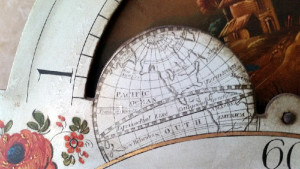 |
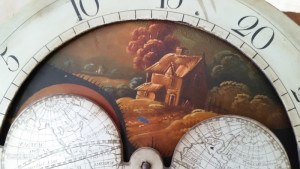 |
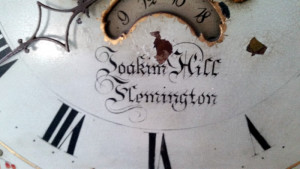 |
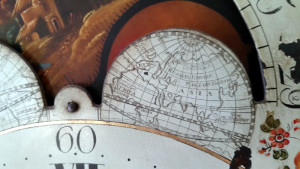 |



